
Associate Professor, Doctor, Associate Professor, Doctor Chu Tan Si, Head of the Department of Neurosurgery - Spine, Tam Anh General Hospital, Ho Chi Minh City, said that spinal and neurological diseases such as herniated disc, spinal degeneration, spinal stenosis, spondylolisthesis, curvature, scoliosis, hunchback, spinal fracture, sciatica, spinal cord tumors... are very complicated.
If in the past, surgery to treat spinal and neurological diseases encountered many difficulties due to old techniques, patients feared that "surgery would cause paralysis"; now, the world's leading modern artificial intelligence (AI) application devices such as the Robot AI Modus V Synaptive, the AI Neuro-Navigation Curve BrainLAB, the AI K.Zeiss Kinevo 900 microsurgical glasses... have opened a new revolution.
High-tech AI helps doctors accurately locate lesions, guide and monitor the surgical path, and preserve nerve fibers and roots around the spine. At the same time, minimally invasive spinal surgery minimizes pain for patients and shortens recovery time.

High success rate, over 95%.
The incision is only 1-2cm, 7-10 times smaller than traditional open surgery.
Reduced blood loss by 79% and shortened surgery time by more than 20%.
Patients have little pain and can walk after only 1-2 days.
Reduce hospital stay by 40%, discharge after 2-3 days.
Return to normal life after only 2-3 weeks, instead of having to rest for 2-3 months like with old surgery techniques.
Cost is 30-40 times lower than surgery in the US with the same technology, fully covered by high-level health insurance.

Robots and AI "super machines" pioneer spinal and neurological surgery in Vietnam.
The AI Modus V Synaptive robot allows doctors to intervene in the spine through a super small incision (about 1cm), preserving maximum soft tissue, avoiding damage to nerves and nerve roots. The robot has the ability to process 3D images integrated from MRI, CT, DSA sources..., helping doctors simulate surgery in advance on specialized software, choosing the optimal and safe incision, personalized for each patient.
During surgery, the robot with a sharp 3D camera, magnified many times, and an automatic moving arm, allows the doctor to clearly observe the bones, spine, herniated mass, nerve bundles, including hidden corners that traditional surgery cannot reach. Thanks to 3D image processing integrated with AI, the robot is like a "magic eye", helping to expand the field of view, guide and warn, ensuring all operations are safe and accurate.
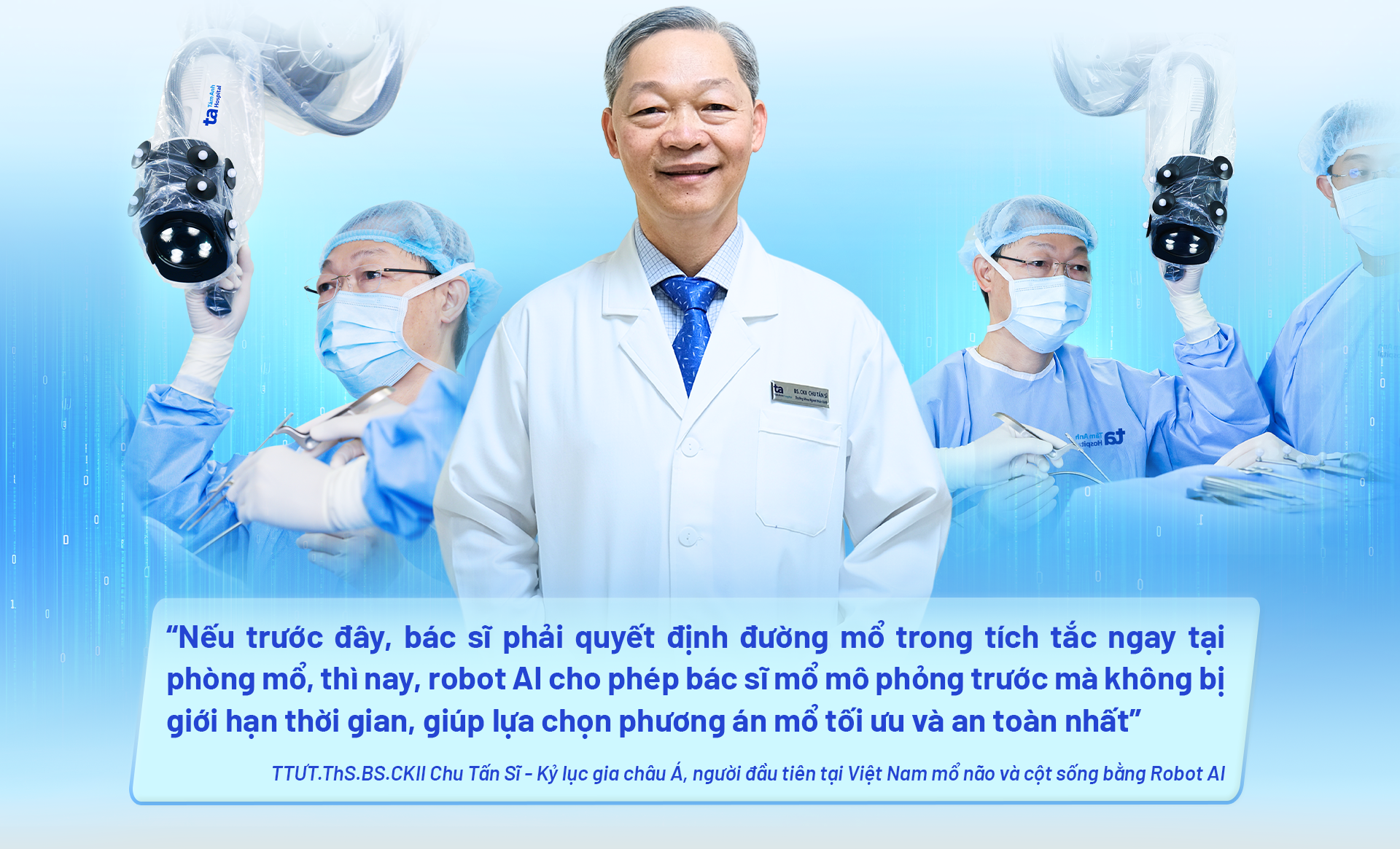

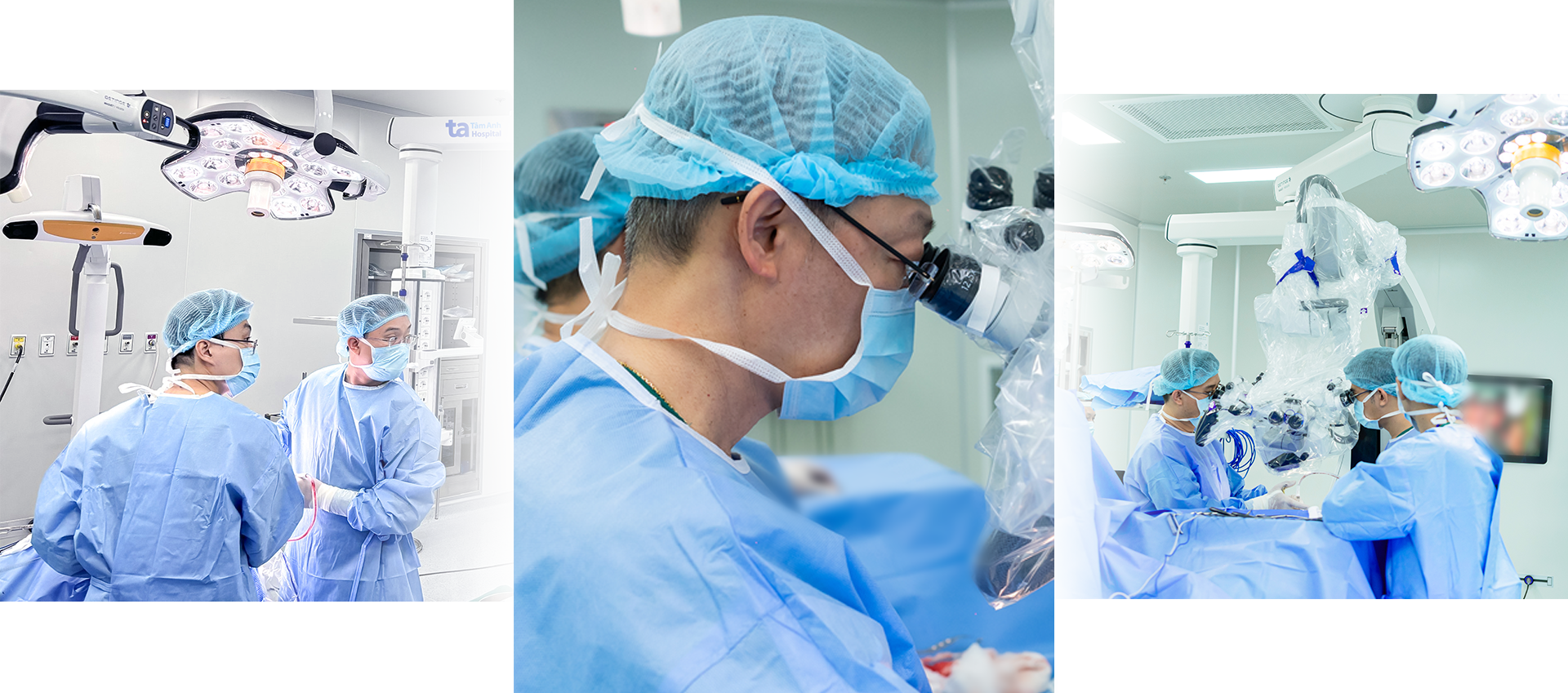
The Neuro-Navigation Curve system acts as a "compass" to help the surgeon navigate the surgical instrument to the correct location of the lesion without damaging the motor-sensory nerves. The K.Zeiss Kinevo 900 microsurgical microscope with integrated AI magnifies 20-25 times, allowing the surgeon to observe in detail the structures of the spine, nerves and lesions such as herniated discs, sharp 3D images, projected directly onto the large screen, ensuring effective surgery, maximum protection of healthy tissue.
In cases requiring fixation such as spondylolisthesis, spinal stenosis, the AI positioning system helps place instruments accurately. In complex surgeries such as spinal cord tumors, spinal vascular malformations, the AI microscope provides optimal vision for precise manipulation down to the smallest detail. The CUSA ultrasound machine supports effective tumor extraction. The neurophysiological monitoring system (IONM) continuously monitors nerve function from the brain to the feet throughout the surgery, sending warnings for the doctor to make timely adjustments.

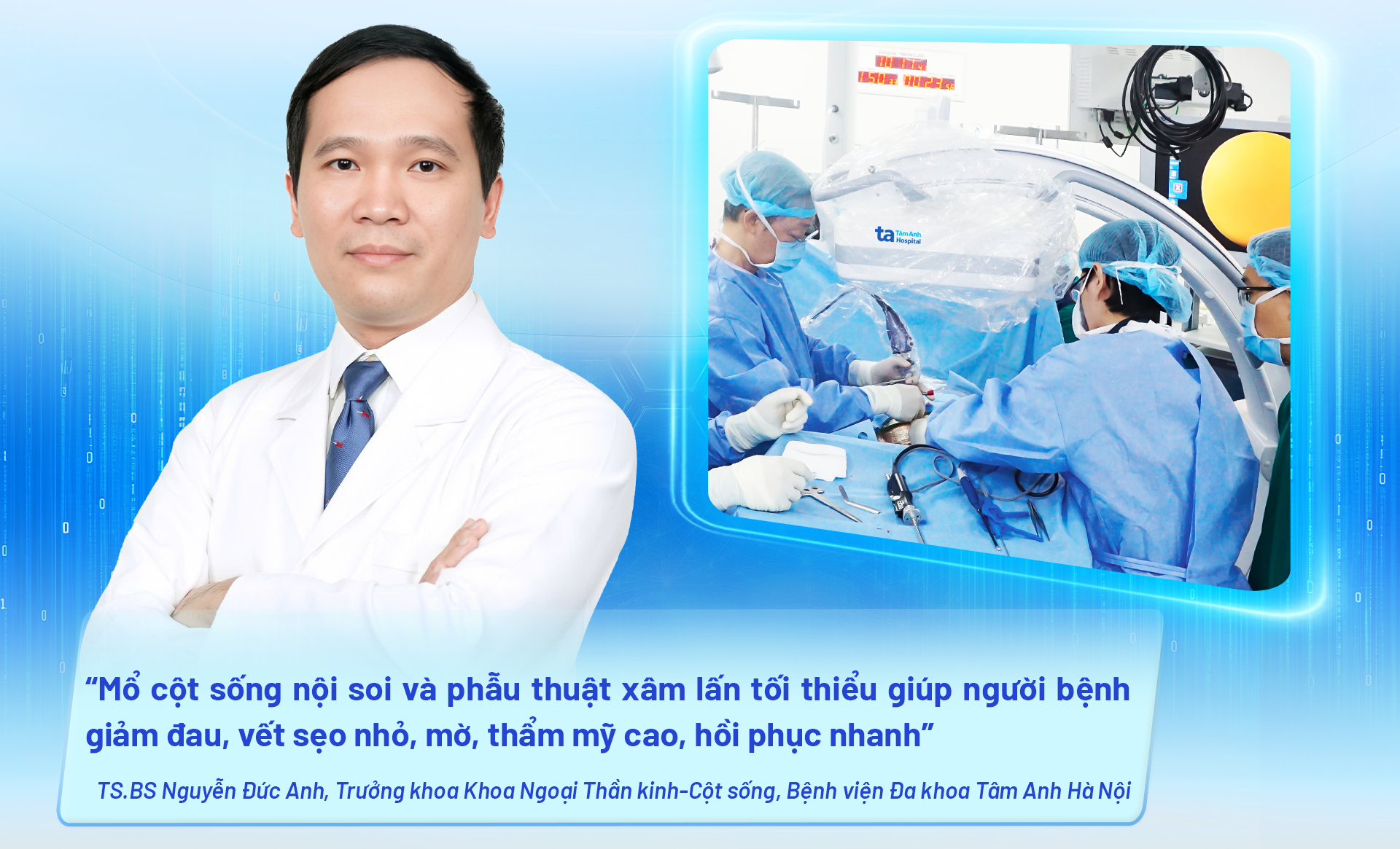
Endoscopic spine surgery UBE and minimally invasive surgery (MISS) are two modern, highly effective techniques in treating disc herniation, spinal stenosis or spondylolisthesis. With a super small skin incision, only 0.4 - 1cm, the technique allows the doctor to accurately treat the injury, reduce post-operative pain, limit blood loss, reduce the risk of complications, preserve the spine and shorten recovery time.
UBE uses two small incisions, inserting an endoscope and surgical instruments into the damaged area, combined with magnified images to help the doctor clearly observe and treat the damage easily without having to widen the incision. Meanwhile, MISS combines the application of modern technologies such as microsurgery, endoscopy system, and nerve guidance to help the doctor perform the surgery safely and accurately. Thanks to minimal invasion, the two techniques help reduce blood loss by up to 80% compared to open surgery, are highly effective, and patients can walk after only 1-2 days.
Doctors operated on a giant hemangioma compressing a girl's spinal cord using an AI robot and high-tech AI at Tam Anh Hospital.

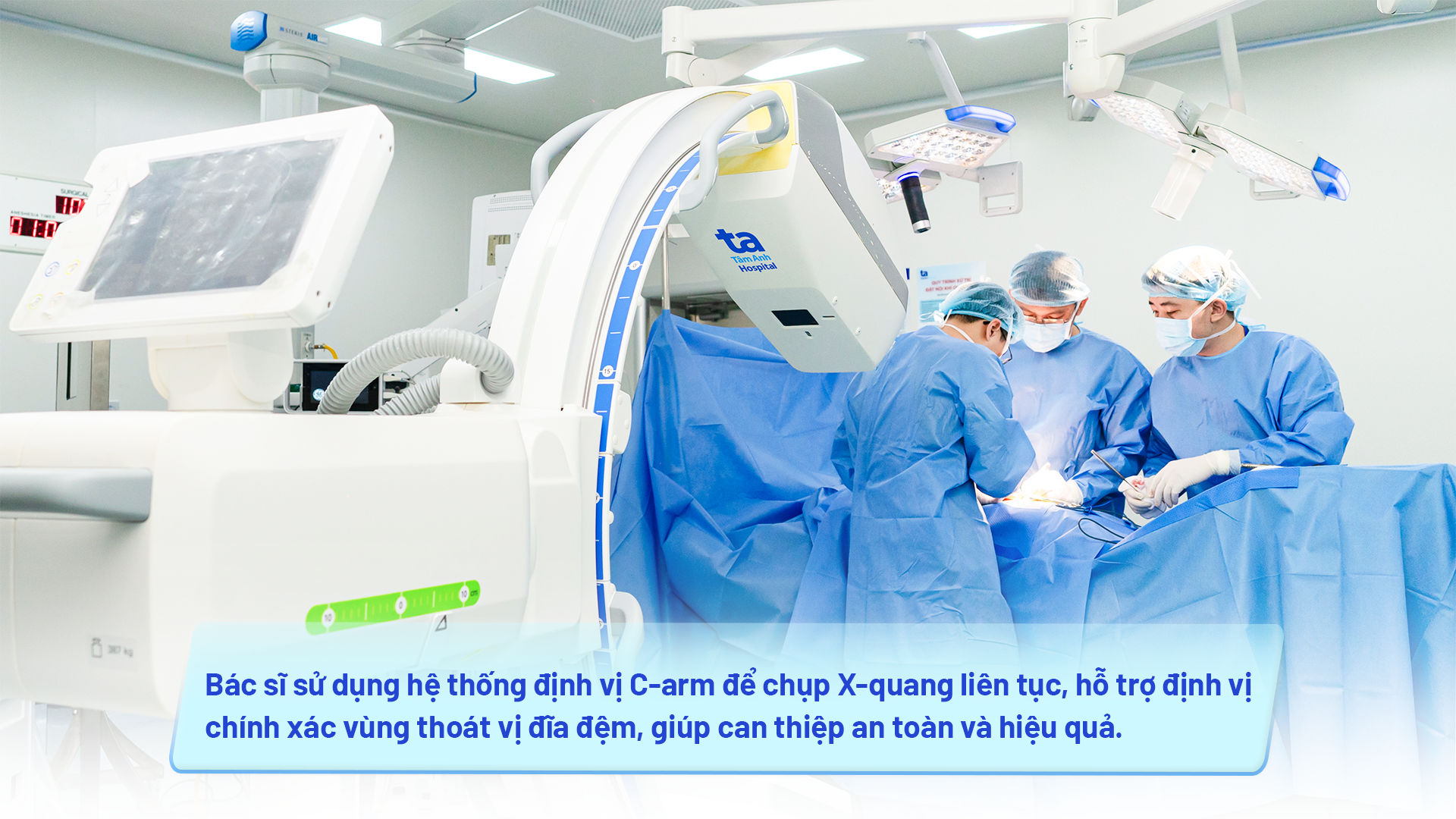
MSc.BS.CKII Ho Huu Dung - Deputy Director of the Orthopedic Trauma Center, Tam Anh General Hospital, Ho Chi Minh City, said that the hospital also owns a series of advanced techniques and modern equipment, serving the effective and specialized treatment of spinal and neurological diseases. Typically, the MISONIX ultrasonic drilling and cutting machines help cut bones accurately. The C-arm positioning system takes continuous X-rays during surgery to help position screws and place instruments safely. The 4K Karl Storz endoscope allows access to nerve structures through an incision of <1cm. The Aesculap high-speed grinding drill helps remove bone spurs quickly and accurately.
"Thanks to the application of modern techniques such as percutaneous spinal screw fixation, interbody fusion, endoscopic discectomy, spinal decompression, etc., we can perform minimally invasive interventions, shortening recovery time for patients," said Dr. Huu Dung.
Along with robots and high technology applying AI in surgery, Tam Anh General Hospital owns the world's leading advanced imaging diagnostic equipment such as CT 768, 1975 and 100,000 slices, MRI 3 Tesla, MRI open rotation 90 degrees... helping to accurately examine spinal and neurological diseases, timely and effective treatment.

Up to now, Tam Anh General Hospital has applied robots and modern technologies and techniques to successfully treat thousands of cases of spinal and neurological diseases.
"We continue to strongly develop AI applications, aiming to become a high-tech Neurology - Spine Center, contributing to building a smart healthcare system for Vietnam," said Dr. Chu Tan Si.
Source: https://dantri.com.vn/suc-khoe/kham-pha-robot-va-cac-sieu-may-ai-mo-cot-song-than-kinh-tien-phong-tai-viet-nam-20250521133757492.htm





![[Photo] Prime Minister Pham Minh Chinh attends the groundbreaking ceremony of Trump International Hung Yen Project](https://vphoto.vietnam.vn/thumb/1200x675/vietnam/resource/IMAGE/2025/5/21/ca84b87a74da4cddb2992a86966284cf)
![[Photo] Determining the pairs in the team semi-finals of the National Table Tennis Championship of Nhan Dan Newspaper](https://vphoto.vietnam.vn/thumb/1200x675/vietnam/resource/IMAGE/2025/5/21/eacbf7ae6a59497e9ae5da8e63d227bf)
![[Photo] General Secretary To Lam works with the Central Inspection Commission](https://vphoto.vietnam.vn/thumb/1200x675/vietnam/resource/IMAGE/2025/5/22/54820e91fd124c4cb691961718c4ee5d)


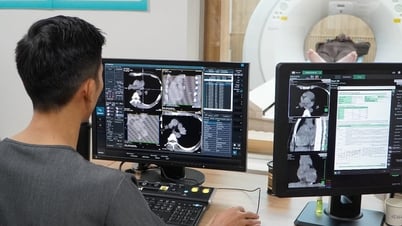


















































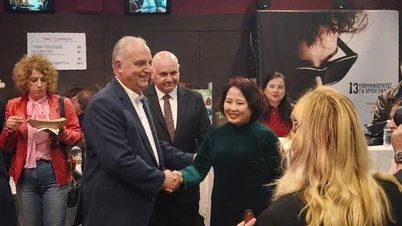
































Comment (0)